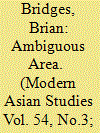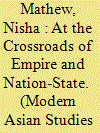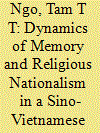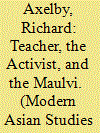|
|
|
Sort Order |
|
|
|
Items / Page
|
|
|
|
|
|
|
| Srl | Item |
| 1 |
ID:
172863


|
|
|
|
|
| Summary/Abstract |
North Korea is a unique regime that has not followed the ‘mono-transition’ path (economic reform under modified one-party rule) of other surviving communist regimes (China, Vietnam, Cuba) in the post-Cold War era. Debates over North Korea's unique features (reluctance in economic reform, absence of political modification, international troublemaking) have generated two contending interpretations. The mainstream interpretation attributes North Korea's uniqueness to its regime's highly rigid political system (‘monolithic leadership system’). For the alternative interpretation, structural pressures and political calculus have driven the monolithic regime towards economic reform (‘marketization from above’), making it more convergent with the ‘mono-transition’ regimes, at least in the economic aspect. In support of the latter interpretation, this article will delve further into three contentious issues that represent the most common doubts about the advance of marketization in North Korea. First, how can the regime reconcile marketization with the interests of its ‘core constituencies’? Second, since ‘crony socialism’ exists, how does it influence distribution and productive activity? Third, how does marketization advance in view of the persistence of monolithic rule? In so doing, it will show how the sources of economic reform (structural factors and political calculus) have enabled the marketization constraints to be overcome.
|
|
|
|
|
|
|
|
|
|
|
|
|
|
|
|
| 2 |
ID:
172860


|
|
|
|
|
| Summary/Abstract |
The Mongolian People's Republic (MPR) became the focus of intense competition between the Soviet Union and Japan in the 1930s, when it was more commonly known as Outer Mongolia. The Soviet Union viewed the MPR as an ideological and strategic ally, and was determined to defend that state against the increasingly adventurist actions of the Japanese military based in northern China. Japanese ambitions to solve the so-called ‘Manmo’ (Manchuria-Mongolia) problem led the Soviets to initiate ever-closer links with the MPR, culminating in the 1936 pact of mutual assistance which was intended to constrain Japanese pressure. Using unpublished Japanese materials as well as Russian and Mongolian sources, this article demonstrates how the Soviet leadership increasingly viewed the MPR as strategically crucial to the defence of the Soviet Far East.
|
|
|
|
|
|
|
|
|
|
|
|
|
|
|
|
| 3 |
ID:
172865


|
|
|
|
|
| Summary/Abstract |
This article investigates gold smuggling in the twentieth-century western Indian Ocean. It illustrates how gold, condemned as a ‘barbarous relic’ by international monetary economists and central banks in the immediate post-war period, created an economy in the intermediate zone between a retreating empire and emerging nation-states in India and the Persian Gulf. Bombay and Dubai—connected by mercantile networks, trading dhows, migrants, and ‘smugglers’—were the principal constituencies and key drivers of this trans-regional economy. Partition and the concomitant flight of Indian mercantile capital into Dubai becomes the key to unlocking the many dimensions of smuggling, including its social organization and ethnic constitution. Looked at in such terms, gold smuggling reveals a transnational side to both partition and the post-colonial history of Bombay which has drawn little critical attention from historians. Consequently, it expands the analytic space necessary to explain how Dubai was able to capitalize on the arbitrage possibilities offered by import regulations in India, tap into the global networks of trade and finance, and chart its own course of development as a modern urban space throughout the latter half of the twentieth century.
|
|
|
|
|
|
|
|
|
|
|
|
|
|
|
|
| 4 |
ID:
172862


|
|
|
|
|
| Summary/Abstract |
This article analyses the dynamics of official and unofficial religious nationalism in the Vietnamese border town of Lào Cai. In 1979 it was one of many Vietnamese towns that were reduced to rubble during the short but bloody war between Vietnam and China. The normalization of Sino-Vietnamese relations in 1991 allowed a booming border trade that let Lào Cai prosper, while the painful memory of this war continued to haunt the town and the daily experiences of its residents, both humans and gods. Since the Vietnamese state forbids any official remembrance of the war, Lào Cai residents have found a religious way to deal with their war memories that skilfully evades state control. By analysing narratives about the fate of the gods and goddesses that reign in the Father God Temple and the Mother Goddess Temple—two religious institutions located right next to the border—this article shows that it is in the symbolism of the supernatural that one can find memories of the war and of the changing social landscape of Lào Cai and reconstruct its history.
|
|
|
|
|
|
|
|
|
|
|
|
|
|
|
|
| 5 |
ID:
172866


|
|
|
|
|
| Summary/Abstract |
The main focus of this article is the Haiphong shipping boycotts of 1907 and 1909–10, which were conflicts over freight rates on rice which arose between several Chinese rice hongs in Haiphong (Hải Phòng), the main port in northeastern French Indochina, and three European tramp shipping companies. When these companies set up a joint agreement in 1907 unilaterally increasing the freight rates for shipping rice to Hong Kong, the affected merchants felt unfairly treated and boycotted the companies’ ships. Furthermore, in 1909, they formed a rival charter syndicate and set up a steamship company chartering the vessels of other companies to apply additional pressure on the firms to return to the previous rate. Although the Chinese suffered direct financial losses due to their insufficient expertise in this business, they were successful in achieving a considerable decrease in the freight rate on rice, which shows that boycotting, even when costly, proved to be an effective means to push for reductions and better arrangements with shipping companies. In contrast to a similar incident in the same trade—the shipping boycott of 1895–96 when the French government intervened with the Chinese government on behalf of a French shipping company—the later boycotts did not provoke the intervention of Western powers. This case suggests that growing anti-imperialism and nationalism in China, expressed in public discourses on shipping rights recovery and in the use of economic instead of political means, had an impact on the boycotts. Economic, not imperial, power determined the outcome of this struggle.
|
|
|
|
|
|
|
|
|
|
|
|
|
|
|
|
| 6 |
ID:
172859


|
|
|
|
|
| Summary/Abstract |
This article explores the thoughts and ideas associated with magic-lantern technology in late eighteenth- and early nineteenth-century Japan. Its primary focus is on trends in Japanese thought from the 1770s until the 1820s, with specific reference to the Rangaku (‘Dutch Studies’) movement. The article examines connections between the magic lantern and a wider discourse within Japan on epistemology, knowledge about nature, and the study of the human body, centring upon the device's vital role in the endeavour to understand the workings of the human eye. Through this lens, a fresh perspective is offered on the role of critical analysis in the translation and interpretation of European texts in Tokugawa Japan, as well as on the shifting prominence of empiricism and deductive reasoning in Japanese epistemology. In this way, the history of the magic lantern is used to look beyond the prevailing West-centred narrative of global technological and intellectual development.
|
|
|
|
|
|
|
|
|
|
|
|
|
|
|
|
| 7 |
ID:
172868


|
|
|
|
|
| Summary/Abstract |
As the Qing state launched its full-scale educational reform at the turn of the twentieth century, tens of thousands of new schools mushroomed all over China. Their urgent and enormous demand for textbooks created a thriving new market that attracted both Chinese and foreign publishing firms. Nurtured in China's traditional book trade, Chinese print capitalists had local knowledge of distribution networks and cultural politics, but not a real command of producing educational Western knowledge. To keep up with Chinese students’ increasing demand for Western knowledge, they pirated textbooks published by foreign companies. Meanwhile, leading American and British publishing corporations were expanding their international business by targeting developing countries that had recently established a modern general education system, like China. Drawing from government and company archives, as well as personal papers and legal documents, this article traces the multinational competition, copyright disputes, and business collaborations between a leading textbook provider in China and their Anglo-American competitors between the 1900s and the 1930s. It illustrates an unexpected and uneasy partnership some foreign publishers formed with Chinese pirates in order to gain better access to China's textbook market. Chinese publishers, on the other hand, used piracy and their local knowledge to bargain for better import credit and deals with their foreign rivals. Both sides were dependent on each other to gain the advantage in their transnational business operations in the globalizing Asian textbook business.
|
|
|
|
|
|
|
|
|
|
|
|
|
|
|
|
| 8 |
ID:
172861


|
|
|
|
|
| Summary/Abstract |
This article is about a cultural-philosophical movement called Russian cosmism (Russky kosmizm) and its current status in the Republic of Kalmykia, southwest Russia, home to Buddhist Kalmyks, a people of Oirat-Mongol origin. Emerging in Russia in the early twentieth century and suppressed during the Soviet period, this movement proliferated openly across Russia with the beginning of perestroika. Promulgated as an original product of the Russian mind, cosmism positions itself as a ‘science of the truth and soul searching’ and purports to address various issues, including—but not limited to—the spiritual, psychic, and paranormal anxieties that are on the rise in Russia. Although Russian cosmism is an all-encompassing movement combining various elements of theosophy, philosophy, poetry, theories of evolution and energy, astrology, cosmology, ecology, and even science fiction, this article focuses upon its more cosmic topics—that is, those that are related to outer space, cosmic energies, and alien visitations, as well as responses to these ideas in Kalmykia. The story of Russian cosmism is not just a story of this particular movement, but also that of science in Russia.
|
|
|
|
|
|
|
|
|
|
|
|
|
|
|
|
| 9 |
ID:
172867


|
|
|
|
|
| Summary/Abstract |
At the turn of the twentieth century, foreign bankers viewed China as one of the up-and-coming markets for international banking. This led to a rapid influx of foreign banks into the banking sector of the China coast. Consequently, foreign banks became a major presence in the treaty ports, where they financed China's foreign trade, provided loans to the Chinese government, and supplied Chinese banks with credit. However, their operations in the Chinese banking sector were always dependent on interaction with Chinese banks. Previous scholarship has largely portrayed the relationship between foreign and Chinese banks in terms of the former dominating and controlling the banking sector of China's treaty ports. This article challenges this view and shows that the relationship between foreign and Chinese banks was one of interdependence rather than one-sided control. It demonstrates how foreign banks had to adapt their business practices to the Chinese business environment and how they were integrated into existing Chinese business networks. Moreover, this article reveals how Chinese entrepreneurs could use their relationship with foreign banks for the benefit of their own business networks and exploit information asymmetries between foreign and Chinese banks to generate profits. The result of the development of this interdependent relationship between foreign and Chinese banks, and of the integration of the former into existing Chinese business networks was the formation of Sino-foreign business networks, which played an important role in making possible the operations of financial markets in China's transnational treaty port economy.
|
|
|
|
|
|
|
|
|
|
|
|
|
|
|
|
| 10 |
ID:
172864


|
|
|
|
|
| Summary/Abstract |
Exploring the intersection of state, religion, and ethnicity, this article considers the opportunities for individual and collective advancement available to Muslim Gujjars in Chamba district of Himachal Pradesh. Following the lives of three prominent members of the community—a teacher, a political activist, and a maulvi—it considers their respective orientations to the state and their relationships with their fellow Gujjars, to illustrate the different ways in which Gujjars have sought to transcend their marginal and subordinated position as an ethnic and religious minority. With state-promoted schemes of affirmative action and reservation offering only limited opportunities for social and economic advancement, we see how Gujjars have responded to their continued marginalization, first through political mobilization as an ethnic group and, more recently, through the establishment of Islamic educational institutions and association with Tablighi Jama'at. This leads to an evaluation of the emancipatory potentials and contradictions of insurgent citizenship when mobilized around specific aspects of ethnic and religious identity. Against a backdrop of economic liberalization and accompanying shifts in civil society, I show how the distribution of rewards that derive from strategies of assimilation, engagement, and withdrawal are structured in particular ways, including by class and gender.
|
|
|
|
|
|
|
|
|
|
|
|
|
|
|
|
|
|
|
|
|